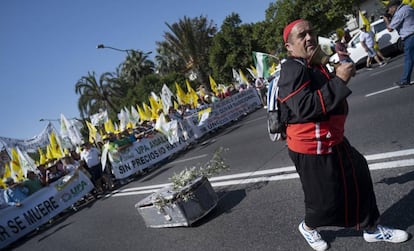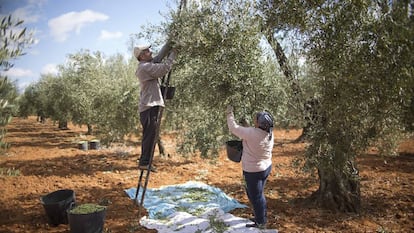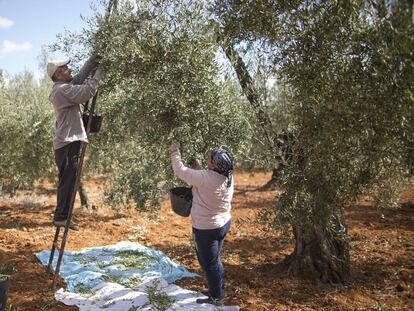Liquid gold? Not for Spanish olive growers struggling to survive
Plummeting prices are being blamed alternatively on speculation and on an excess of supply

Nicolás Casado, an olive grower in Porcuna, in the Andalusian province of Jaén, threw in the towel last January after 37 years of producing what was once considered green gold.
The price of olive oil has fallen drastically from €3.60 per kilo to €2.05 in just two years. “The cost of production has started to be way more than what is being made selling the oil,” he says. “I was struggling on loans. It was ruining me, and I have had to abandon the farm. It was the hardest decision of my life.”
I have had to abandon the farm. It was the hardest decision of my life
Nicolás Casado, grower
Casado is not the only one in Porcuna who is struggling. In a municipality with a population of 6,600, oil accounts for 90% of the economic activity. Aside from a little manufacturing and commerce, 4,680 of the 5,200 people in employment are in the olive oil industry, and the fluctuating prices are causing many to feel aggrieved.
“People can see that there are speculators, retailers, distributors and packaging companies that are getting rich with their products without actually working with them or sacrificing anything for them,” says Miguel Moreno, the mayor of Porcuna.
The fluctuations have prompted a 25% drop in economic activity in this rural village in the last year, affecting opportunities and jobs.
Casado and Moreno participated in a recent demonstration in Seville along with 16,000 Andalusian olive growers early in July to demand decent prices and a halt to speculation in the sector. In late June, Andalusian growers were being paid €2.20 per kilo of extra virgin olive oil, according to the Ministry of Food, Agriculture and Fisheries. This is 43% less than in 2017, when the price stood at €3.94 per kilo.
Prices in Spain, lower than in Tunisia and Greece
The price that Spanish olive growers are paid for their product, €2.20 per kilo, is below the fetching price in Tunisia (€2.33) and Greece (€2.55). In Italy, by comparison, operators sell their oil at high prices, and pay growers €4.74, reaching a record €5.21 in April.
“There are no objective reasons for oil to be worth €5 in Italy, €2.5 in Greece and €2 in Spain. It’s a purely speculative situation,” says Francisco Moreno, of the UPA union in Andalusia.
Out of the 1.8 million tons of olive oil produced in Spain this year, Andalusia accounts for 80%, or 1.4 million. But despite the fact that exports and national consumption have risen by 17% and 11% respectively since last year, according to the National Association of Edible Oil Refiners and Packagers (ANIERAC), the situation has become untenable for many of the 300 municipalities in Andalusia whose economy depends on olives, and where 200,000 entrepreneurs generate 20 million daily wages. “We are living in ruinous times,” says Francisco Moreno, secretary of the UPA-Andalusia union.
Ramón García, speaking from the agricultural union COAG’s headquarters in Seville, points at the alleged culprits: “Big national companies and the sector’s industry leaders take advantage to speculate.” He goes on to single out those in retailing, packaging and distributing activities as being responsible for the industry’s woes. This is upheld by UPA-Andalusia, which refers to the trio’s “speculative activities.”
But ANIERAC denies the accusations and maintains that inertia in the market and the laws of supply and demand are responsible. This association says that the current fall in prices is due to massive surpluses, with as much as 1.13 tons of oil unsold. They also forecast that in October, when the next olive oil harvest gets underway, 700,000 tons will still be on the shelf. Of all the olive oil produced, 25% is for national consumption and 75% for export.

Spain remains the world’s top exporter of olive oil, and 52% of domestic production is sold abroad. Paradoxically, Italy is the biggest buyer of Spanish oil: it has purchased 107,000 tons so far this year. Much of that is bottled and sold to third countries with labels suggesting an Italian origin for marketing purposes.
Meanwhile, the Spanish Association of Distributors, Self-service and Supermarkets (ASEDAS) denies that there is anything odd influencing the price of olive oil, and insists it complies strictly with the contracts signed with the producers. This association – one of three in charge of Spain’s olive oil distribution – also blames the drop in prices on the products’ global position.
Despite the huge outcry at the demonstration in Seville, the sector remains divided. The Food and Agriculture Cooperatives federation and the ASAJA union did not join the demonstration, and they believe the collective protest was a mistake. Jaime Martínez, managing director of the federation of 350 cooperatives, leans towards measures in partnership with the authorities in order to revert the situation.
In a move in this direction, the Spanish minister of Food, Agriculture and Fisheries, Luis Planas, aims to draft a proposal that would encourage a self-regulated supply – in other words, the seasonal storage of oil, a measure that is already being implemented in the wine sector. And the government will ask for updated baseline thresholds to set this private storage in motion.
This measure would apply to harvests that produce an excess of oil and a resulting drop in prices, allowing the additional oil to be taken off the market, with Brussels paying the growers for the surplus. The baseline threshold is currently fixed at €1.80 per kilo, an indicator that has not been changed in the last 20 years. The olive producers want it to be bumped up to €2.50, which would at least cover the cost of production.
English version by Heather Galloway.
Tu suscripción se está usando en otro dispositivo
¿Quieres añadir otro usuario a tu suscripción?
Si continúas leyendo en este dispositivo, no se podrá leer en el otro.
FlechaTu suscripción se está usando en otro dispositivo y solo puedes acceder a EL PAÍS desde un dispositivo a la vez.
Si quieres compartir tu cuenta, cambia tu suscripción a la modalidad Premium, así podrás añadir otro usuario. Cada uno accederá con su propia cuenta de email, lo que os permitirá personalizar vuestra experiencia en EL PAÍS.
¿Tienes una suscripción de empresa? Accede aquí para contratar más cuentas.
En el caso de no saber quién está usando tu cuenta, te recomendamos cambiar tu contraseña aquí.
Si decides continuar compartiendo tu cuenta, este mensaje se mostrará en tu dispositivo y en el de la otra persona que está usando tu cuenta de forma indefinida, afectando a tu experiencia de lectura. Puedes consultar aquí los términos y condiciones de la suscripción digital.
More information
Archived In
Últimas noticias
Rowan Atkinson tops Netflix at 70: ‘He’s as funny as ever’
Israeli recognition of Somaliland stirs up the Gulf
Tiger Woods turns 50: Will he continue playing on the PGA Tour or take a back seat?
The surreal journey of James Nnaji, the Barcelona youth player selected in the NBA Draft who ended up in the NCAA
Most viewed
- Oona Chaplin: ‘I told James Cameron that I was living in a treehouse and starting a permaculture project with a friend’
- Reinhard Genzel, Nobel laureate in physics: ‘One-minute videos will never give you the truth’
- Sinaloa Cartel war is taking its toll on Los Chapitos
- Why the price of coffee has skyrocketed: from Brazilian plantations to specialty coffee houses
- Chevy Chase, the beloved comedian who was a monster off camera: ‘Not everyone hated him, just the people who’ve worked with him’










































